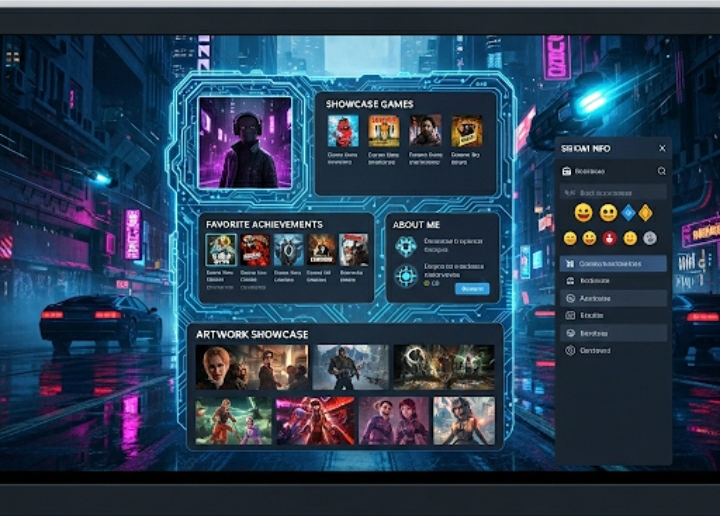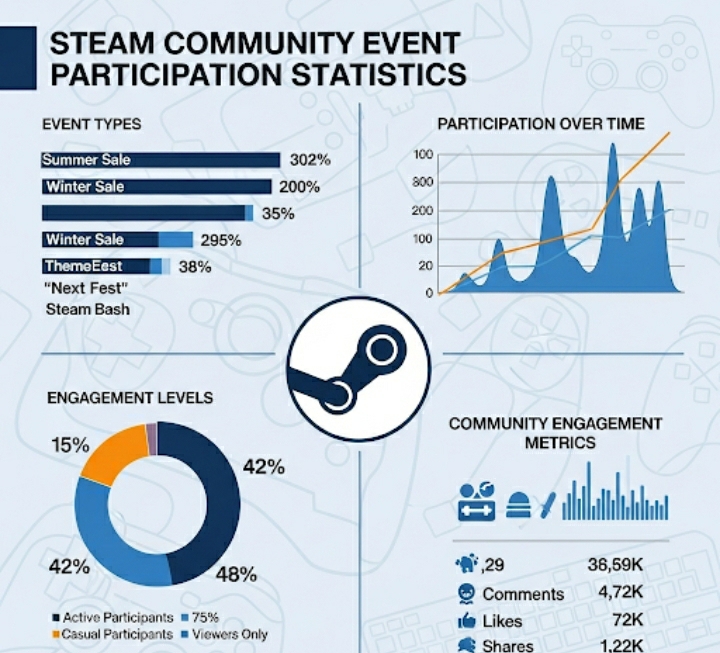Last month, I watched my introverted cousin transform from a solo gamer hiding behind single-player campaigns to the leader of a 200-member Steam group dedicated to indie horror games. What started as a simple comment on someone’s screenshot became a thriving community that now hosts weekly game nights and has even organized real-world meetups across three states.
This transformation isn’t unique. Exploring the Steam Community has become the secret weapon for millions of gamers seeking genuine connections beyond random matchmaking and toxic lobby chat. Whether you’re tired of playing alone or looking to elevate your gaming experience through meaningful relationships, Steam’s social ecosystem offers unprecedented opportunities to connect with like-minded players.
In this guide, you’ll discover actionable strategies to navigate Steam’s social features, build authentic gaming relationships, and transform your solitary gaming sessions into collaborative adventures that extend far beyond your screen time.
Understanding Steam’s Social Landscape
The Foundation: Your Steam Profile as Your Gaming Identity
Your Steam profile serves as your digital handshake in the gaming world. Think of it as your gaming resume meets social media profile. A well-crafted profile includes:
- Professional-quality screenshots showcasing your favorite gaming moments
- Achievement highlights that demonstrate your dedication and skill
- Game reviews that reflect your personality and gaming preferences
- Custom artwork or backgrounds that express your unique style
The key lies in authenticity. Rather than trying to impress everyone, focus on accurately representing your gaming interests and personality. This attracts genuinely compatible gaming partners.

Decoding Steam Groups: Your Gateway to Gaming Communities
Steam Groups function as specialized clubs within the larger Steam ecosystem. With over 150,000 active groups covering every conceivable gaming niche, finding your tribe requires strategic searching.
Primary Group Categories:
- Game-specific communities (perfect for mastering specific titles)
- Genre-focused groups (ideal for discovering new games in your preferred style)
- Regional communities (excellent for finding local gaming events)
- Skill-based groups (competitive players seeking similar dedication levels)
Success in group participation comes from contributing value before seeking benefits. Share helpful tips, offer genuine compliments on others’ achievements, and participate in discussions with meaningful insights rather than generic responses.
Mastering Steam Community Features for Connection
Steam Forums: Where Conversations Become Relationships
Steam Forums often get overlooked, but they’re goldmines for building deeper connections. Unlike quick group chat messages, forum discussions allow for thoughtful exchanges that showcase your expertise and personality.
Effective Forum Engagement Strategies:
- Solve problems before asking for help – Research thoroughly, then ask specific questions
- Share detailed game guides – Create valuable content that positions you as knowledgeable
- Participate in ongoing discussions – Add unique perspectives to existing conversations
- Support newer players – Helping others builds your reputation and expands your network
The magic happens when you consistently provide value. I’ve seen players gain hundreds of friends simply by creating comprehensive mod installation guides or troubleshooting common technical issues.
Steam Workshop: Collaborate Through Creativity
The Steam Workshop transforms content creation into community building. Whether you’re designing custom maps, creating character mods, or developing game assets, the Workshop facilitates collaboration that naturally evolves into lasting friendships.
Workshop Connection Opportunities:
- Collaborative projects where multiple creators contribute skills
- Feedback exchanges that develop into mentorship relationships
- Beta testing groups for testing each other’s creations
- Cross-promotion partnerships between complementary content creators
Strategic Networking Through Steam Events and Activities
Game Events: Turning Participation into Partnership
Steam’s seasonal events, game launches, and community challenges create natural conversation starters. These limited-time activities generate shared experiences that bond participants.

During last year’s Steam Summer Sale, active participants in trading card events reported 40% more friend requests and group invitations compared to passive users. The shared goal of completing badge collections created countless interaction opportunities.
Steam Broadcasting: Building Audience Relationships
Steam’s built-in broadcasting feature allows you to stream directly to the Steam community without requiring external platforms. This creates more intimate viewing experiences compared to larger streaming services.
Broadcasting Best Practices for Community Building:
- Consistent scheduling helps viewers know when to find you
- Interactive gameplay where you respond to chat suggestions
- Educational content teaching strategies or exploring game lore
- Community game nights featuring viewer-suggested titles
Advanced Community Navigation Techniques
The Art of Steam Friendship Management
Quality trumps quantity in Steam friendships. Rather than adding every player you encounter, focus on building meaningful connections with compatible gamers.
| Connection Type | Best Approach | Expected Outcomes |
|---|---|---|
| Casual Gaming Buddies | Meet through group activities | Regular game sessions, shared discoveries |
| Competitive Teammates | Connect via ranked gameplay | Skill improvement, tournament participation |
| Creative Collaborators | Workshop partnerships | Joint projects, skill sharing |
| Local Gaming Friends | Regional groups, events | Real-world meetups, local gaming scenes |
Community Moderation and Leadership Opportunities
As you become established in Steam communities, leadership opportunities naturally emerge. Moderating groups, organizing events, or creating content positions you as a community pillar while expanding your network exponentially.
Leadership Benefits:
- Enhanced visibility within your chosen gaming niches
- Direct messaging privileges with community founders and key members
- Event organization experience that transfers to real-world skills
- Networking opportunities with other community leaders
Maintaining Long-Term Gaming Relationships
Beyond Steam: Expanding Connections Across Platforms
Successful Steam community relationships often extend beyond the platform itself. Discord servers, social media groups, and even real-world meetups become natural progressions of strong Steam connections.
The transition typically follows this pattern:
- Initial Steam interaction through groups or games
- Regular gaming sessions that build familiarity
- Discord or social media connection for easier communication
- Collaborative projects that deepen the relationship
- Long-term friendship that transcends gaming
Avoiding Common Community Pitfalls
Not all Steam community interactions lead to positive outcomes. Understanding potential challenges helps you navigate the social landscape more effectively.
Red Flags to Recognize:
- Overly aggressive recruitment for groups or games
- Persistent requests for personal information beyond gaming preferences
- Pressure to participate in trading or financial transactions
- Toxic behavior disguised as “competitive spirit”
Trust your instincts. Genuine gaming friendships develop naturally without pressure or manipulation.
Conclusion
Exploring the Steam Community transforms solitary gaming into a rich social experience filled with learning opportunities, creative collaborations, and lasting friendships. The platform’s diverse ecosystem supports every type of gamer, from casual weekend warriors to dedicated competitive players.
Your journey starts with authentic self-presentation, continues through valuable community contributions, and flourishes as you help others while pursuing your own gaming goals. The connections you build today become the foundation for years of enhanced gaming experiences.
Ready to dive deeper into Steam’s social features? Start by optimizing your profile this week, join three relevant groups, and make your first meaningful contribution to a community discussion. Share your favorite Steam community discovery in the comments below – your experience might inspire another gamer to take their first step toward building lasting gaming connections.
Frequently Asked Questions
How long does it typically take to build meaningful connections in Steam communities?
Building genuine Steam community connections usually takes 2-4 weeks of consistent participation. This timeframe allows for multiple interactions across different contexts (group discussions, game sessions, forum posts) that demonstrate your personality and reliability. However, some connections form immediately during intense gaming sessions or collaborative projects.
What’s the best way to find active Steam groups in my specific gaming interests?
Use Steam’s advanced group search with specific game titles, genres, and activity filters. Look for groups with recent posts (within the last week), active member counts above 100 but below 10,000 (sweet spot for engagement), and clear group descriptions. Join 3-5 groups initially to test engagement levels before committing to regular participation.
Is it safe to share personal information with Steam community members?
Limit personal information sharing to gaming-related details initially. Share your preferred game genres, playing schedule, and general location (city/state level) only after establishing trust through multiple positive interactions. Never share financial information, detailed personal schedules, or home addresses regardless of relationship duration.
How can I contribute meaningfully to Steam communities without being overly promotional?
Follow the 80/20 rule: 80% helpful contributions (answering questions, sharing tips, celebrating others’ achievements) and 20% self-promotion (sharing your content, inviting to events). Always provide value before seeking benefits, and ensure your promotional content genuinely helps community members rather than just benefiting yourself.
What should I do if I encounter toxic behavior in Steam communities?
Document the behavior with screenshots, use Steam’s reporting tools immediately, and block the problematic user. Notify group moderators or administrators about the incident. Don’t engage in arguments or retaliation, as this often escalates situations and may reflect poorly on your community standing.
Can Steam community connections lead to professional gaming opportunities?
Absolutely. Many professional gaming careers begin through Steam community connections. These relationships can lead to competitive team invitations, content creation collaborations, beta testing opportunities, and even job offers from gaming companies. Maintain professionalism in all interactions and view every connection as a potential professional opportunity.
Sources:
- Steam Community Statistics and User Engagement Report – Valve Corporation Official Documentation
- “Building Online Gaming Communities: A Comprehensive Guide” – Game Developers Conference Research Publications
- Steam User Behavior Analysis – Gaming Industry Analytics Platform Studies